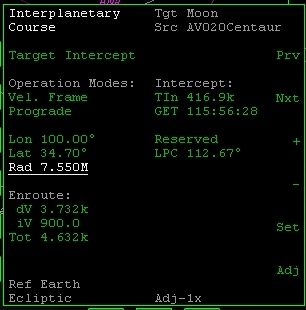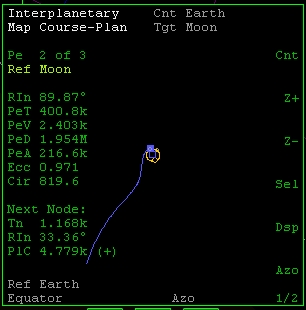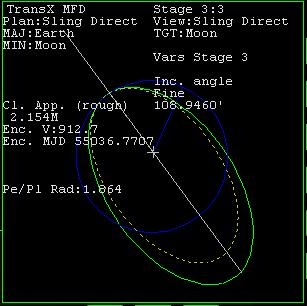Lunar Reconnaissance Orbiter (BrianJ add-on)
Overview
The Lunar Reconnaissance Orbiter (LRO) is the first mission in NASA's planned return to the moon. LRO is scheduled to launch 24th April, 2009, with the objectives to finding safe landing sites, locate potential resources, characterize the radiation environment and test new technology.
The return to the moon will enable the pursuit of scientific activities that address our fundamental questions about the history of Earth, the solar system and the universe -- and about our place in them. It will allow us to test technologies, systems, flight operation and exploration techniques to reduce the risk and increase the productivity of future missions to Mars and beyond. It will also expand Earth's economic sphere to conduct lunar activities with benefits to life on our home planet.
LRO is an unmanned mission to create the comprehensive atlas of the moon's features and resources necessary to design and build a lunar outpost. LRO focuses on the selection of safe landing sites, identification of lunar resources and the study of how lunar radiation will affect humans.
After launch, the LCROSS shepherding spacecraft and the Atlas V’s Centaur upper stage rocket will execute a fly-by of the moon and enter into an elongated Earth orbit to position LCROSS for impact on a lunar pole. On final approach, the shepherding spacecraft and Centaur will separate. The Centaur will act as a heavy impactor to create a debris plume that will rise above the lunar surface. Following four minutes behind, the shepherding spacecraft will fly through the debris plume, collecting and relaying data back to Earth before impacting the lunar surface and creating a second debris plume.
The debris plumes are expected to be visible from Earth- and space-based telescopes 10-to-12 inches and larger.
This is a difficult and challenging mission. Experienced orbinauts will enjoy the challenge of targeting the LCROSS to impact the North Pole of the moon, when the LRO spacecraft is overhead. This mission is not recommended for people recently starting to use Orbiter. Familiarity with setting up gravity assist maneuvers in TransX is a required skill.
Mission Objectives
LRO
The objective of the LRO mission is to map the lunar surface in preparation for the return of human missions to the moon, which are planned to occur by 2020.
LCROSS
Earth’s closest neighbor is holding a secret. In 1999, hints of that secret were revealed in the form of concentrated hydrogen signatures detected in permanently shadowed craters at the lunar poles by NASA’s Lunar Prospector. These readings may be an indication of lunar water and could have far-reaching implications as humans expand exploration past low-Earth orbit. The Lunar CRater Observing and Sensing Satellite (LCROSS) mission is seeking a definitive answer.
Required add-ons
- IMFD 4.2.2
- Multistage2015 for Orbiter 2010 (install the add-on and copy "Multistage2015.dll" under the "Modules" folder to "Multistage2.dll")
optional add-ons
Spacecraft Specifications
LRO
- Empty Mass 809kg
- Fuel Mass 897kg, ISP 2100Ns/kg
- Main Engine 352N
- RCS 20N
LCROSS
- Empty Mass 592kg
- Fuel Mass 300kg, ISP 2200Ns/kg
- Retro Engine 44N
- RCS 4.5N
AV020Centaur
- Empty Mass 1914kg
- Fuel Mass 20672kg, ISP 4200Ns/kg
- Main Engine 99400N
- RCS 1000N
NOTE: When AV020Centaur fuel is finished, control is automatically switched to LCROSS propulsion system.
Spacecraft Controls
Available commands are displayed on the top-left of the vessel HUD
AV020Centaur
P = Toggle Parking Orbit Autopilot On/Off
J = Jettison LRO
B = Manual Purge Centaur Fuel (automatic at 32000km alt.)
K = Jettison LCROSS
V = Deploy/Delete LCROSS "Bullseye" target on Moon N.Pole
N = Display LRO Lunar Orbit Data
M = TransX cheat! Enable 44N "ghost" Main Engine for use with TransX
LRO
G = Deploy Antenna (automatic Earth tracking)
K = Deploy Solar Panel (automatic Sun tracking)
N = Activate Laser Altimeter
V / ShiftV = Rotate DLRE Azimuth
B / ShiftB = Rotate DLRE Elevation
LCROSS
F8 = View from Visual Context Imager (6 deg FOV)
LC-41 (Launch Pad)
V = LOX Vent On/Off
K = Lights Off
NOTE: LC-41 is automatically deleted when focus vessel is above 100km alt.
Add-on Notes and Quick Info
NOTES
Moon Orientation
The precession of the Moon's axis is not modelled in Orbiter. To ensure accuracy of the Moon's orientation at the time of the mission, the LRO add-on uses a custom sol.cfg and moon.cfg located in the Config/LRO/ directory. To use them, the "Environment" entry in the scenario file must point to the LRO/sol.cfg.
e.g.
BEGIN_ENVIRONMENT System LRO/Sol Date MJD 54892.2256944444 END_ENVIRONMENT
Launch Date
Although the launch is currently scheduled for 24th April 2009, the primary launch scenario provided in this add-on is the 27th April 2009 due to the mission constraints on the LAN of LRO's final Lunar orbit. The second launch scenario provided is for the 24th April 2009, should you wish to use it.
Transx version
This document assumes the default Transx version supplied with Orbiter. Other versions may give different lunar intercept times.
QUICK INFO
LRO
Final Lunar orbit - 30km x 70km, 90deg inclination(Equatorial), Periselene over South Pole,
LAN = 38deg(Ecliptic) +/- 17deg(max.)
LCROSS/AV020Centaur
Uses Lunar flyby to reach high-inclination Earth orbit,
Spacecraft:Moon orbit resonance 2:3 (other resonances possible)
Impact chosen target at North Pole of Moon (targets designated by surface bases "Lcross_A" to "Lcross_E"), impact speed ~2.5km/s, impact angle > 60deg.
Lcross separates from AV020Centaur at impact -9hrs. Lcross impact 4mins after AV020Centaur.
Impact should be timed to be visible by LRO passing over and by ground-based observers in Hawaii during hours of darkness.
Procedures
Accuracy of burns in this mission is CRITICAL.
Launch
Fire up the 01 - AV020 LRO launch 27Apr scenario in the LRO scenarios folder This is a night launch so visibility is poor until after the TLI burn. The scenario starts at UTC 04/27/2009 04:09:00. Launch time is UTC 04:10:11. The default camera view is Ground Observer. You have just over a minute to set up the camera to your personal preference.
At UTC 04:10:01 press the p key to start the launch countdown and 1st stage auto-pilot.
At T-5 seconds, engine ignition will happen, and the hold down clamps release at T-0. The Atlas V-401 1st stage autopilot will continue until 1st stage seperation.It can be disengaged by Pressing p again, but this is not recommended.
10 seconds after 1st stage separation, press the p key again.
This will ignite the 2nd stage Centaur engine, and engage the 2nd stage autopilot which will put the vehicle in a circular 185km parking orbit. Pressing p again will disengage the 2nd stage autopilot.
Shortly after 2nd stage ignition, the fairing will be automatically jettisoned, and the LRO/LCROSS spacecraft will be exposed.
TLI
After SECO, while established in the 185km parking orbit, set the Left MFD to IMFD.
Also, click the HUD button in the right orbit MFD so that your HUD is set to orbit reference Earth Click the Prograde button to engage the prograde autopilot.
IMFD Configuration set-up
Click MNU, then Configuration. Click Nxt, then + to change the Mission timer to MJD mode. Click Nxt ten times to hightlight Parking Orbit Alt. Click Set, and set this to 185k
Establishing the TLI burn
Click MNU, then Course. Target Intercept should be highlighted. If not, click Nxt until it is. Click Set Click Tgt and enter Moon Click Nxt 6 times so that Off Plane is highlighted. Click + twice to change it to Source Plane. Click Prv so that Realtime is higlighted. Click + to change it to Off-Axis Click Prv twice so that TIn is highlighted. Click + or - repeatedly to minimize the value of PlC in the lower left section of the MFD. You may want to click on ADJ and set it to 10x for this adjustment. Be sure to set it back to 1x when finished. Click Prv twice so the Tej parameter is highlighted. Click + or - repeatedly until the EjA parameter is about 3 degrees. If you go much below 3 degrees the Off-Axis parameter will change back to Realtime, and we need to be in Off-Axis mode. The dV parameter should be about 3.15k at this point.
Select IMFD in the right MFD also.
Click MNU, then PG. Enter 0 for the MFD ID. Click Map. Click Tgt, and enter Moon. Click PG, then Plan. Clidk PG, then click Sel until Ref Moon appears in yellow text. Click MOD 3 times, then click Nxt so that Accuracy is highlighted. Click - twice so that accuracy is set to Max. Click MOD twice to return to the map display with equatorial parameters.
Wait until the TEj parameter in the left display is 1k or less.
In the left MFD, Click MOD, and Offset Disabled should be highlighted. Click + twice and Vel. Frame should be displayed. Click Nxt until Lon is highlighted. Click Set and enter 65. Click Nxt and Lat should be highlighted. Click Set and enter -59.8. Click Nxt, then Set, and enter 20.3M for Rad. Adjust the Rad and Lat parameters to get the PeA and EqI parameters in the right MFD as close as possible to 350k and 90 degrees. Repeat as necessary. Click Pg, then BV, then AB. Disengage the Prograde autopilot.
Sit back and wait for the burn. You may wish to use time acceleration to get close to the burn time, but set it back to 1x acceleration once you get close.
When the TLI burn is complete, click on the BV button to restore the main IMFD Course target intercept screen. Click MOD, then Prv until Vel. Frame is highlighted. Click + so that Offset Disabled is shown. Click MOD three times to return to the main target intercep screen. Also, in the right MFD, click Pg, then Plan to disengage plan mode.
Press the j key to jettison LRO. Switch focus back to LRO. Press the k key to deploy the LRO solar panels Once the panels have fully unfolded, and rotated to face the sun, press the g key to deploy the antenna
Lunar targeting/LCROSS
- Swingby of moon is passive (no thrusting)
- 84 days in post-swingby cruise orbit
- Current baseline is a 3 Lunar orbit:2 Spacecraft orbit trajectory with north pole impact
- Two revolutions in high ecliptic inclination (~50 deg), 42-day period Earth orbit
When you reach 32M altitude above the Earth, the Centaur engine will automatically purge of all fuel and control switches over to the LCROSS propulsion system. You may initate the engine purge manually by pressing B. It is critical that you get your targeting done for LCROSS before this time, as once that happens, your deltaV budget is severely limited.
Switch focus to AV020Centaur. Select Orbit MFD in the right MFD. At about 21M altitude above the earth, select IMFD in the Right MFD.
Click MNU, then Map. Make sure Target is Moon, and Ref moon is displayed. Click MOD three times, and set Accuracy to Max. Click MOD again to return to the map display. Use rotational thrusters to point the Centaur in a northward direction. (Towards Polaris) Switch to translation mode and use linear thrusters until PeA in the Right MFD is about 2M. In the left MFD be sure Target Intercept is highlighted. Click +, then Nxt four times until Delta Velocity is highlighted. Click Set. Click TGT, and type Moon. Click Nxt, then Set, and set TEj to 400. Click Nxt three times until dVf is highlighted. Click Set, and enter 0. in the Right MFD, click Plan so the green course line turns blue. In the left MFD, adjust dVp and dVf so that RIn and PeA in the right MFD are as close as possible to 90 degrees, and 1.5M, respectively. Click Prv until TEj is highlighted and set it to 0. Click PG, BV, and AB. When the burn is finished, click BV, and PG in the left MFD, and Plan in the right MFD.
Select Transx in both MFDs. Select moon as the target in the right MFD
Click the FWD button for stage 2, make sure the view is Setup and select the target as Escape. Click the FWD button again for stage 3, and select the target as Moon Click the VW button for Sling Direct view. On the Left MFD, click the FWD button for stage 2, if not already there. Click the VW button for slingshot view, if not already there.
There will be a green line extending from the center of the moon to hopefully past the edge. This is an edge-on view of our current approach to the moon. We need to fine tune this approach to give us a lunar gravity assist which will result in a highly inclined orbit around the earth with a period of 42 days
On the Right MFD, click the VAR button twice to bring up the Inc. angle parameter Click on ++ several times until the dotted yellow orbit is about the same size as the solid green line. It does not have to be superimposed in the same place, but of a similar diameter.
On the Left MFD the dotted yellow line should be on the same side (more or less) of the moon as the green line. If it is on the opposite side, click on the -- button until it is on the same side.
On the Right MFD, click on VAR four times until the outward angle parameter is shown. Adjust this parameter, and the Inc. angle parameter until the dotted line is superimposed on the solid green line in the slingshot view.
This is our current trajectory. Now we need to adjust the trajectory to impact the moon in 2 orbits with a 42 day period.
Note the angle of this line. We will be adjusting the length of the line, but the angle must remain the same so that our flight path is over the moons pole. On the Right MFD, click VW so that the setup view is shown Click VAR 3 times so that Orbits to Icept is shown Click ++ 4 times so that the Orbits to Icept parameter is 2.0
Now we must figure out what our Enc. MJD should be. Take the current MJD and add 88.5 to it. (4.5 days to reach the moon, then 2 orbits of 42 days each.) For the 27 April(UTC) launch this would be 54948.2 + 88.5 = 55036.7 . This is the Enc. MJD we will be shooting for.
Click VW again in the right MFD to get back to sling direct view. Adjust the Inc Angle to get as close as possible to the desired MJD. When the angle strays too much, click VAR so that Outward angle is displayed. Adjust Outward angle to bring the lines back into alignment. Repeat the above process, until the date is as close as possible to the target date. Click ADJ so that the increment is Fine Adjust Outward angle to get the Cl. App. as close as possible.
My current solution is Inc Angle of 110.99 degrees and Outward angle of -38.1864. Enc MJD is 55036.6951, and Cl. App is 6.726M
Your Mileage may vary.
Once a solution has been reached, click BCK twice on the Right MFD. The View should be Maneuver and Maneuver mode should be off. Click ++ to turn Maneuver mode on Adjust Prograde Vel. and Ch. Plane vel. until the dotted yellow line on the Left MFD lines up with the solid green line. R. Inc should be as close as possible to 0, and Pe Ratio should be as close as possible to 1.000. Once this is done, click VW in the right MFD to get to target view. Use rotational thrusters to get the cross in the middle of the target and burn until Rel.V is as close to 0 as possible. Click VW twice to get to maneuver view, Click VAR to get to Maneuver mode and turn it off. Look at the Left MFD to see how you did. Additional corrections may be done as you get closer to the moon.
See also
Lunar Reconnaissance Orbiter Lunar Reconnaissance Orbiter part 2



